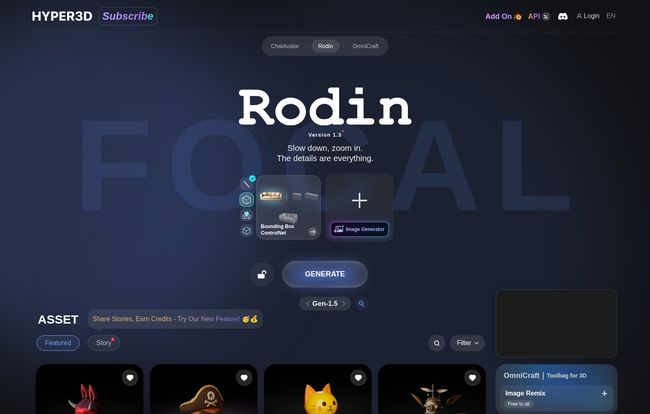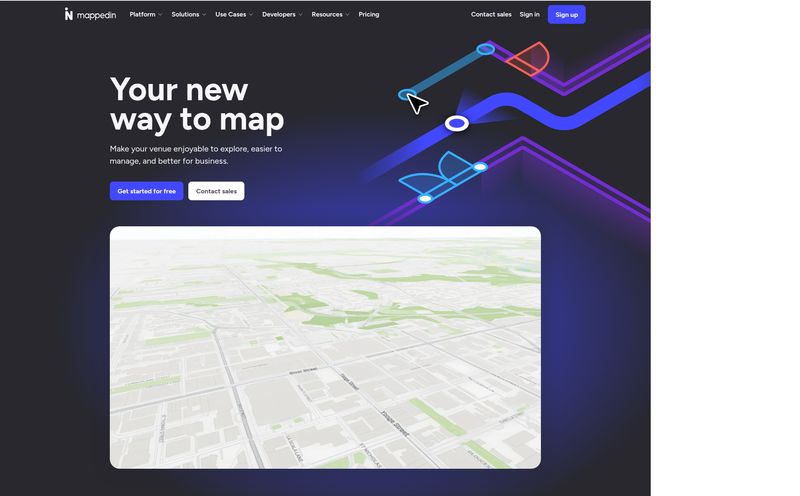I remember my first tango with 3D modeling software. It was Blender. And let me tell you, it felt less like a creative dance and more like trying to assemble IKEA furniture in the dark while someone shouts technical jargon at you. The learning curve wasn't just steep; it was a sheer cliff face. For years, that's just how 3D was—a specialized skill reserved for those with the patience of a saint and the time to master incredibly complex tools.
Then AI crashed the party. We saw it happen with text, then with 2D images. Tools like Midjourney and DALL-E turned everyone into a potential concept artist overnight. It was only a matter of time before that same disruptive energy hit the third dimension. And that's where platforms like Hyper3D come marching in.
I've been keeping a close eye on the text-to-3D space, and Hyper3D has been making some serious noise. But is it just another flashy AI toy, or is it a genuinely useful tool for professionals and hobbyists alike? I decided to pop the hood, kick the tires, and see if it lives up to the hype.
So What Exactly is Hyper3D?
First things first, Hyper3D isn't just one thing. Thinking of it as just a text-to-3D generator is like calling a smartphone just a phone. It's a suite of tools. A whole workshop, really, all packed into a clean web interface. The platform aims to be an all-in-one solution for creating and manipulating 3D assets, and it’s built around a few core components:
- Rodin AI: This is the headliner. The free AI 3D model generator that creates models from text prompts or images.
- OmniCraft: A tool for remixing and tooling up your 3D assets.
- Vecto3d & Texture Generation: For creating assets and realistic surface textures from simple inputs.
- Mesh Editor, Model Viewer, & Format Convertor: The practical, get-it-done tools that let you actually use what you create.
The whole idea is to take the headache out of 3D creation. To make it faster, more intuitive, and accessible to people who don't have a computer science degree. A noble goal, for sure.
Taking Rodin AI for a Spin
Let's get to the fun part: Rodin AI. This is where the magic is supposed to happen. The interface, as you can see, is beautifully simple. There's a big prompt box, an 'Image Generator' button, and a giant 'GENERATE' button. No confusing menus, no endless parade of cryptic icons. It’s refreshing.

Visit Hyper3D
You type in what you want—say, “a cute pirate captain character, chibi style”—and the AI gets to work. You can also feed it a reference image to guide the creation, which is a fantastic feature. The main page showcases a gallery of assets created by the community, complete with likes and creator credits. It has a bit of a social, collaborative feel, which I think is a smart move. It stops it from feeling like a sterile utility and more like a creative playground.
Now, for the million-dollar question: is it any good? The answer is... it depends. Like most generative AI right now, the quality can be a bit of a mixed bag. I’ve generated some things that were genuinely impressive and usable right out of teh box. I’ve also generated things that looked like they melted in the sun. This variability is the current reality of AI generation, but the hit rate on Hyper3D is surprisingly high. You just have to be willing to tweak your prompts and try a few times.
More Than Just a One-Trick Pony
While Rodin gets all the attention, the other tools in the Hyper3D suite are what make it a potentially serious workflow solution. It’s one thing to generate a cool-looking model; it’s another thing entirely to make it ready for a game engine or a 3D scene.
Textures, Skies, and Everything In-Between
The Texture Generation is a huge bonus. Creating seamless, realistic textures is an art form in itself. Being able to generate them with AI is a massive time-saver for game developers and environment artists. The HDRI generator is another pro-level feature. For those not in the know, an HDRI is a high-dynamic-range image that wraps around your 3D scene, providing both realistic lighting and reflections. It's the secret sauce for making a render not look like a render, and having a generator for it on-hand is incredibly convenient.
The Nuts and Bolts: Editing and Converting
This is where Hyper3D really tries to bridge the gap between hobbyist and professional. The built-in Mesh Editor allows for quick tweaks and clean-up without having to export to another program. The Model Viewer is straightforward, and the Format Convertor is honestly a lifesaver. Being able to easily convert between formats like FBX, OBJ, and GLB is critical for making sure your assets can actually be used in different pipelines, whether you're working with Unity, Unreal Engine or something else entirely.
Let's Talk About the Money: Hyper3D Pricing
Alright, nothing's ever truly free, right? While you can play around with Rodin AI without pulling out your wallet, the real power comes with a subscription. Hyper3D uses a credit-based system, which is pretty standard for AI services. Here’s a quick rundown of their plans:
| Plan | Price | Credits | Ideal For |
| Education | $12 /month | 30 credits | Students and educators. It's awesome they offer this. |
| Creator | $24 /month | 30 credits | Hobbyists and individual creators. |
| Business | $60 first month, then $120 /month | 208 credits | Small studios and professional freelancers. |
| Enterprise | Contact for details | Custom | Large studios needing custom integration and support. |
The credit system seems to be the currency for most generations and advanced features. Thirty credits on the Creator plan might go fast if you're experimenting a lot, so you have to be a little mindful. The free experience is limited, mainly to single-image generation, so a subscription is necessary to unlock things like multi-image fusion and exporting for commercial use.
The Good, The Bad, and The AI-Generated
So, after all that, what’s my verdict? It’s a mix, as with most things in life.
On the one hand, Hyper3D is brilliantly accessible. It lowers the ridiculously high barrier to entry for 3D creation. It's fast, the interface is clean, and the free generator is genuinely fun to use. It’s like the Canva for 3D models—it empowers people to create things they otherwise couldn’t. That is a massive, undeniable win.
On the other hand, it’s a subscription service, and to get the most out of it, you need to pay. The variable quality of generations means it's not a magic button that spits out a perfect, production-ready asset every single time. It's a tool that requires some guidance and iteration. Some might argue that this lack of absolute control is a drawback compared to traditional software like ZBrush where every vertex is under your command.
Who is Hyper3D Really For?
In my experience, a tool's value is all about who is using it. So who gets the most out of Hyper3D?
- Indie Game Developers: Without a doubt. The ability to rapidly prototype 3D assets, create textures, and get them into a game engine is a huge boost for small teams and solo devs.
- 3D Artists & Hobbyists: It's a fantastic tool for ideation. You can quickly generate a base mesh or a concept in Hyper3D and then take it into Blender or ZBrush for detailed sculpting and refinement. It breaks through creative blocks.
- Marketers and Designers: Need a quick 3D icon for a website or a simple product mockup for a presentation? This is way faster than hiring a 3D artist for a small job.
Who isn't it for? Probably high-end VFX artists for major film productions who need flawless topology and UVs for intense animation. Not yet, anyway. But for the 90% of other use cases, it's surprisingly capable.
At the end of the day, Hyper3D is an exciting glimpse into the future of creative workflows. It's not a replacement for skilled artists, but rather a powerful new tool in their arsenal—one that's also simple enough for a complete beginner to pick up and make something cool in minutes. It successfully tears down that intimidating wall that has surrounded 3D creation for so long.
Is it worth your time? Absolutely. Go to their site, try out the free Rodin AI generator, and see what you can dream up. You might just be surprised at what you create.
Frequently Asked Questions
- What is Hyper3D?
- Hyper3D is an online platform that provides a collection of AI-powered tools for creating 3D assets. Its main features include Rodin AI for text-to-3D model generation, as well as tools for texture generation, mesh editing, and file format conversion.
- Is there a free version of Hyper3D?
- Yes, Hyper3D offers a free tier. You can use its Rodin AI generator to create 3D models from text. However, more advanced features, unlimited private models, and commercial use rights typically require a paid subscription.
- How does the credit system work in Hyper3D?
- Hyper3D's paid plans operate on a credit system. Each month, your account receives a set number of credits (e.g., 30 for the Creator plan). These credits are used to perform actions like generating models or using certain advanced tools. More complex generations might require more credits.
- What file formats does Hyper3D support?
- Hyper3D is designed for flexible workflows and supports several standard 3D file formats, including FBX, OBJ, and GLB, making it compatible with most game engines and 3D software.
- Can I use the models I create for commercial projects?
- This depends on your plan. Generally, the free tier models are for personal use, while the paid subscription plans (like Business) grant you the rights to use your creations for commercial purposes.
- Is Hyper3D better than traditional 3D modeling software?
- It's different, not necessarily better. Traditional software like Blender or Maya offers granular control but has a steep learning curve. Hyper3D offers speed and ease of use, making it ideal for rapid prototyping and ideation, but it doesn't provide the same level of manual control. Many artists use them together.



